ISSN
2307–3489 (Print), ІSSN
2307–6666
(Online)
Наука
та прогрес транспорту. Вісник
Дніпропетровського
національного університету залізничного
транспорту, 2018,
№ 3
(75)
ЕЛЕКТРИЧНИЙ
ТРАНСПОРТ
електричний
транспорт
UDC
621.336
D.
V. USTYMENKO1*
1*Dep.
«Electrical Engineering and Electromechanics», Dnipropetrovsk
National University of Railway Transport named after Academician V.
Lazaryan, Lazaryan St., 2, Dnipro, Ukraine, 49010, tel. +38 (056) 373
15 47,
e-mail ustimenko.1979@gmail.com,
ORCID 0000-0003-2984-4381
PHYSICO-TECHNOLOGICAL
ASPECTS OF WORK OF LUBRICANT
FILMS IN THE
TRIBOSYSTEM «OVERHEAD
LINE – CURRENT
COLLECTOR CONTACT
STRIP»
Purpose.
The article aimed at comprehensive
analysis of
the processes
occurring in
the lubricant
films of
the friction
surfaces of
the tribosystem
«overhead line
– current
collector contact
strip» (OLCCCS)
and identification
of the
features of
such systems.
Methodology.
The systematic analysis was used as the
main methodology for studying the physico-technological aspects of
work of the lubricant films in the tribosystem «overhead
line – current collector contact strip».
Findings.
The theory
of
electro-friction
interaction is
now at
such a stage
that is
characterized by
a large
amount of
accumulated
empirical data,
hypotheses and
models that
cannot
adequately
represent
phenomena in
a sliding,
high-current
electrical
contact. The
sliding
electrical contact
of the
tribosystem
«overhead line – current collector
contact strip» during
the operation
is affected
by many
factors, one
of which
is the
processes in the lubricating
layers of
the friction
pair. The
work leads to a new level of understanding of the peculiarities of
the processes occurring in the lubricating layers and their effect on
the work of a sliding, high-current electrical contact, which can
become the guarantee of significant increase in the efficiency of
such systems and, as a consequence, substantially increase the
reliability and safety of the work of the electric stock.
Originality.
It is proposed to consider the
processes of
electro-friction
interaction of
electrical
contacts from the
position of
synergy using
the theory
of fractals
as the
core one for
the quantitative
description of
self-organizing
structures.
Practical
value.
Taking into
account the
empirical
experience of
operation of
the tribosystem
«overhead line
– current
collector contact
strip» in
combination with
theoretical
knowledge allows
us to
propose three
possible
directions for
solving
tribological
problems in
high-current
sliding
electrical
contacts. They are:
1) change in
contact geometry
and surface
topography, for
example, the
use of
regular
macrorelief of
contact surfaces;
2) development of
conductive
composites which
are characterised
with
self-lubrication,
for example
the use
of composite
materials
containing solid
conductive
lubricants; 3)
development of
effective
lubricants for
electric
high-current
sliding contacts,
which may
require some
complication of
the component
design.
Keywords:
contact pair; current collection; overhead line; wear rate;
limit friction; contact transient resistance; current collector
contact strip
Introduction
The «current
collector – overhead line»
system has an important task of transmitting energy from the power
grid to the vehicle board. Consequently, a reliable electrical
contact between the current collector and the overhead line is
directly related to the reliability of operation and the safety of
train movement.
During operation, the overhead line and the contact strip of the
current collector are exposed to multiple sliding friction, heating,
erosion, etc., which makes the evolution of the contact quite
complicated. An important role in the sliding contact operation is
played by the antifriction lubrication.
Purpose
The main
purpose of the work is a comprehensive analysis of the processes in
the lubricant films of the friction surfaces of the tribosystem
«overhead line
– current collector contact strip»
(OLCCCS) and the identification of features of such systems.
Studies
aimed at
determining the
peculiarities of
the processes
occurring in
the lubricating
layers of
the friction
surfaces of
the tribosystem
of OLCCCS
should be
considered
relevant in
scientific and
practical terms,
since taking
into account
these features
can provide
a significant
increase in
the efficiency
of tribosystems
of this
class [3, 4, 14,
15].
Methodology
To achieve the purpose set forth
in the work, it is envisaged to study the physico-technological
aspects of the work of the lubricating layers in the tribosystem
«overhead line – current collector contact strip». The system
method is used as the main methodology.
Findings
The theory of
friction and wear of surface layers under conditions of boundary
lubrication was studied in the works by Kostetsky B.
I. [7], Bauden
F. P. and D.
Tabor [5], Kragelskiy I. V.
[8] Ahmatov O. S.
[2], Chichinadze A. V.
[13].
It is known that the work of
sliding contacts is closely related to friction and wear. Therefore,
it is necessary to consider not only the electrical properties of
the sliding contacts, but also the phenomenon of friction and wear.
In the general case, if the two purified surfaces are brought into
contact at the interatomic distance, then the same gravity forces as
in the volume of the material act between them. Several types of
forces can be distinguished:
– ionic
bond occurs
between anions
and cations
that are
held by
electrostatic
forces;
– covalent
(homopolar) bond
between neutral
atoms is
accomplished by
overlapping
their electron
fields, which
leads to
the emergence
of
a
strong bond;
– metallic
bond is
characteristic
of all
metals and
is due
to the
presence of
electrons, which
move freely
between the
ion lattice
sites;
– Van
der Walsh
bond can
occur between
any atoms
or molecules
due to
dipole-dipole
interaction.
Each atom in
the material volume interacts with its closest neighbours by means
of the above forces. The specific energy associated with this
interaction is called cohesive energy and it plays an important role
in the processes of friction and wear. Atoms on the surface have
fewer neighbours, respectively, they do not have bonds outside the
body (Fig. 1) [10]. For this reason, the surface of the solid has
some impractical energy, which determines the surface's ability to
form adhesive compounds.
The presence of surface energy
causes the interaction of the surface with the environment
(including with lubricants), which is called adsorption and leads to
the formation of boundary layers. As a result of adsorption on the
surface there are always elements of adjacent phases.
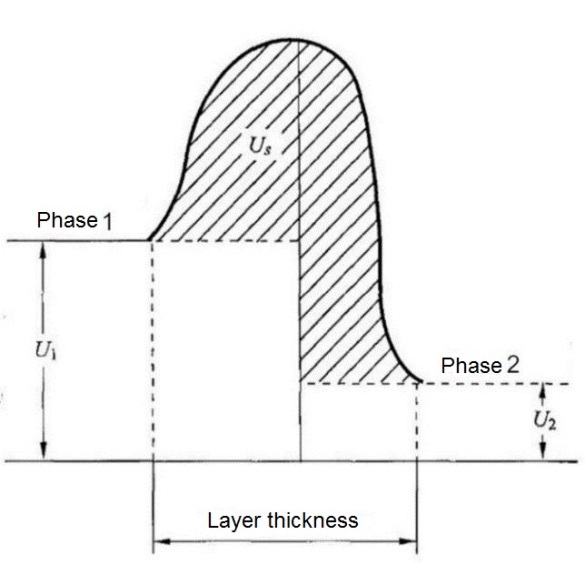
Fig. 1. Energy of
boundary layer Us when
contacting two
phases 1 and 2, having the surface
energy
U1 and U2 (by Kashchev)
Physical
adsorption is
characterised
with Van
der Walsh
interaction of
adsorbate with
the body
surface. The
polymolecular adsorption layers formed on the surface are relatively
easily removed.
In the process of chemical
adsorption, the energy of interaction is quite large, and on the
surface there is usually formed a monolayer that is difficult to
remove.
Thus, the adsorption activity of
surfaces leads to the fact that they form a thin boundary layer,
which differs in structure and properties from the surface
(transition) layer of a solid. The physical state of matter of such
a boundary layer may be different and depends both on the parameters
of the state (temperature, pressure, etc.) and on the nature of the
interaction with the solid phase.
Adhesion of
the rubbing surfaces in many respects determines the patterns of
friction and wear. Surface layers undergo various changes during
friction; these changes can be both inverse and irreversible,
causing wear, seizure and other phenomena.
The primary source of these
processes, and in some cases the main reason, is the stress-deformed
and the thermal state of frictional contact.
Friction in
the conditions of boundary lubrication is accompanied by the
formation between the working surfaces of a thin layer of lubricant,
which acquires the properties of the «third
body»
(according to Kragelskyi
I. V. [5, 8]).
According to DSTU 2823-94, the
term «boundary friction» is to be understood as «lubrication in
which conditions of friction and wear of surfaces moving in relation
to one another are determined by their properties, as well as by the
properties of the lubricant, which differ from the bulk viscosity of
the lubricant material».
The term «lubricating layers»
of lubricants still has no unambiguous interpretation within the
limits of DSTU, but in generalized form it is interpreted as
follows: the lubricating layers of lubricants on solid lyophilic
surfaces are «quasicrystalline molecular layers with a
multimmolecular epitropon-liquid-crystalline structure» [1].
The lubricant
in the boundary layer is anisotropic, so the molecular layers in the
tangential direction slip one relative to the other. In the normal
direction to the surface of friction the bearing capacity of the
boundary layer is high and the deformation of its compression is
within the limits of elasticity.
Friction with a semifluid
lubricant occurs in the case of simultaneous action of liquid and
boundary lubrication. The normal load is balanced by the compression
resistance of the lubricant film in contact spots and the forces of
hydrodynamic pressure in the layers of lubrication. The share of the
reaction of boundary or liquid lubricant depends on the load, the
speed of the mutual slip of the surfaces, the state of the surfaces,
as well as the amount and viscosity of the lubricant. The
hydrodynamic effect of the lubricant is manifested when it enters
the macrogeometric gap between the friction surfaces.
To date, a wide range of models
of tribological systems (friction without transmission of electric
current) has been considered in detail, and a system of indicators
of contact interaction, as well as methods for their determination,
has been developed. The geometric characteristics of surfaces are
introduced: macro-deviation, wavelength, roughness,
submicroroughness; characteristics of contact areas – visible,
contour, actual; types of contacts – elastic, elastic-plastic,
plastic, etc. [13].
One of the contact elements
(overhead line) is made of metal in the friction pair of OLCCCS, the
main material of the second contact element (current collector
contact strip) is solid-lubricating electrically conductive
compositions of four basic types: metal graphite, graphite, carbon
graphite and electro-graphite. Such compositions are characte-rised
with the formation of friction of transferred films on a metal
counterbody.
Experimental
studies have shown that the thickness, composition and structure of
the transferred films are interrelated with the external parameters
of the sliding contact (load, speed), composition of the composite,
counterbody and the environment [11]. At the same time, the film
determines the mechanism of passing the current, and, respectively,
the electrical characteristics of the contact, the nature and
intensity of heat dissipation. The film thickness and the degree of
coating of the metal counterbody inequality are, from this point of
view, the most important factors of its effect, as illustrated in
Fig. 2.
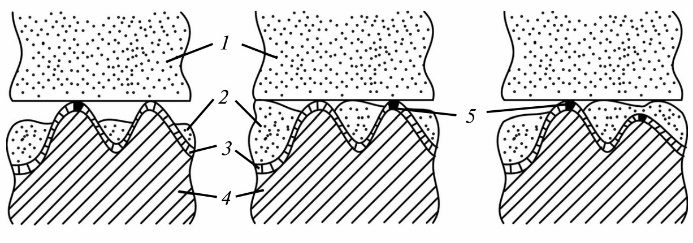
Fig.
2. Models of
transition layer
on the metal
surface oxidized
when working in
pairs
with
self-lubricating
contact material:
1
– self-lubricating contact material; 2
– transferred material; 3
– film of oxides; 4
– metal; 5
– areas
with
tunnel-conductive or destroyed oxide film
The
electric current
can be
considered as
an additional
external
parameter of
the tribosystem,
which affects
all
characteristics
of the
sliding contact.
This effect in many cases is so significant that the concept of
«lubricating action» of electric current (reduction of frictional
force with increased current density) and «electrical» wear
(excessive wear of elements of a sliding contact in comparison with
so-called mechanical wear in the absence of current) are specially
introduced.
In carbon graphite and
electro-graphite overlays, the increase in the current density,
which passes through the contact, as a result of heat dissipation,
reduces the strength of the surface layer and its shift resistance
that results in the effect similar to the lubricant introduction
into the contact. This effect is reversed.
For graphite
brushes having a relatively high (up to 25% by weight) content of
non-carbonated (polymeric) binder, the «lubrication effect» above
a certain critical current density is irreversible and is expressed
rather sharply, since heat dissipation causes the destruction of the
binding material and composition.
When applying
metal-graphite materials with high metal content (weight percent –
up to 90%), the effect of current density on the friction
coefficient is practically non-existent and only with high current
density (more than 20 A/cm2)
the friction coefficient increases slightly. In such materials, the
amount of transferred material on the counterbody is insignificant,
and the frictional behaviour of such compositions is close to the
behaviour of metals.
It is
difficult to predict the intensity of contact wear by the current
density magnitude due to the variety of current factors and the
complex nature of their interconnection. The main factors of wear in
the absence of electric sparking and arc formation are as follows:
oxidation of the metal element of friction pair; growth of adhesion
due to the dissociation of films of water or organic matter under
the action of current; oxidation of the composite element of
friction pair and weakening of its strength; emergence of
shock-thermal stresses in a dynamic contact due to the uneven
distribution of the current density in it [9, 11, 12]. All factors
can act simultaneously and their main root cause is the heat release
on the transient contact resistance. In the case of sparking or arc
formation, the listed factors are added with electroerosion and
emissions of contact material in the arc discharge, which increase
the intensity of wear.
In the
contact, the total surface of the section is divided into many
individual spots. In this connection, when the energy flow passes
through such a
surface there is the additional resistance introduced by the
violation of the homogeneity of the flow lines – the
constriction resistance. It is added,
in general,
with resistance
of the
films of
the following
varieties:
adhesive films,
passive films,
tarnish films
(oxide,
sulfide), water
films, films
from wear
products [6].
Each
component of
the
heterogeneity of
the contact
zone corresponds
to the
component of
the total
constriction resistance [6].
Holm proposed to take into account the two
components, corresponding to the constriction to the group of spots
and constriction within the boundaries of this group. For bodies
with the same specific resistance ,
which have one group of round, uniformly distributed spots, the
following expression is obtained:
 , (1)
, (1)
where
 – total number
of contact
spots;
– total number
of contact
spots;
 – spot radius;
– spot radius;
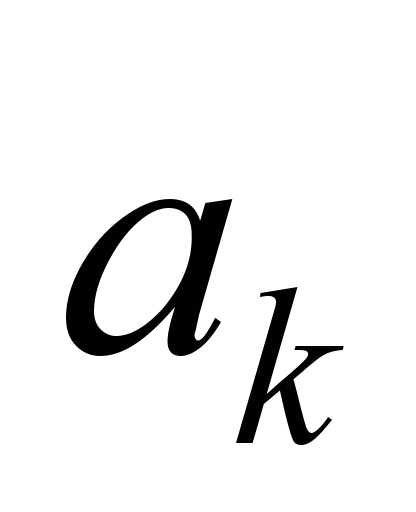 – radius of
circle
encompassing the
contact spots;
– radius of
circle
encompassing the
contact spots;
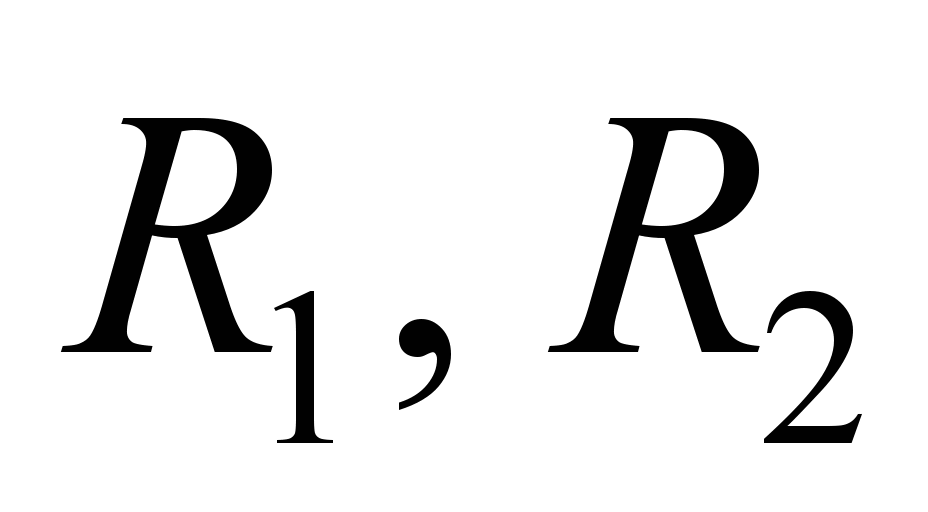 – components
of resistance,
which correspond
to the
constriction of spots and
their groups.
– components
of resistance,
which correspond
to the
constriction of spots and
their groups.
Greenwood [16] clarified the
second term of expression (1):
 , (2)
, (2)
and
it is
shown that
its value
is practically
the same
for any
placement of
contact spots
in the
general group.
The Greenwood formula has also
been expanded by members that take into account the asymmetry of the
distribution of groups of spots on each other, as well as the
distribution of groups on the nominal area [18].
In
the process
of current
collecting, the
overhead line
and the
contact element
are heated,
with the
importance of
the relationship
between the
energy of
the losses
(Al)
and the
heat dissipation
(Ahd)
that is
released into
the environment.
With a
certain limit value ΔA= Al – Ahd, the preconditions are
created, which leads to plastic deformation of the contact surfaces
with subsequent melting.
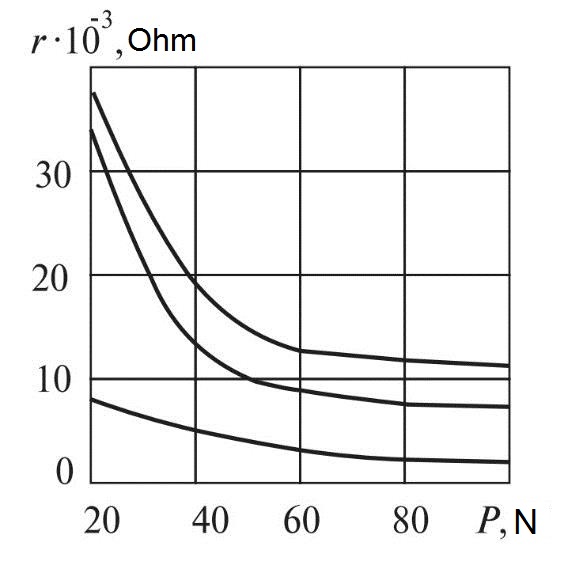
Fig.
3. Dependence
of transient
resistance
on
the pressing
force for
different materials
One of the
main indicators of the quality of electrical contact is the drop in
voltage
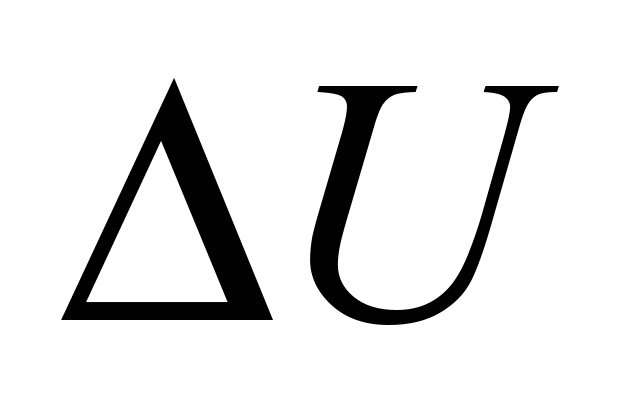 on it:
on it:
 , (3)
, (3)
where
 – current through contacts,
– current through contacts,
 – transient resistance of the contact
pair.
– transient resistance of the contact
pair.
Of course, the value of the
transient resistance of the contact pair of OLCCCS is affected by
the contact press; the change of the contact pressure even within
the permissible limits is accompanied by a change in the transient
resistance, illustrating the dependence on Fig. 3 [11].
Increasing
the transient resistance of the contact pair, for one reason or
another, leads to growth of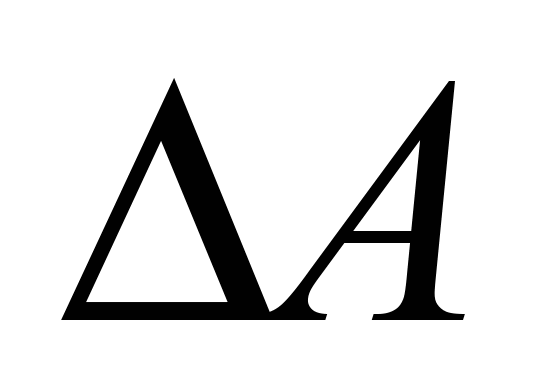 .
.
An
increase in
the actual
contact area
in the
friction pair
helps to
reduce the
transient
resistance .
Thus, using contact resistance and
topography relationship data, we can give recommendations for
constructing contacts, for example, the use of a
regular macrorelief of contact surfaces.
.
Thus, using contact resistance and
topography relationship data, we can give recommendations for
constructing contacts, for example, the use of a
regular macrorelief of contact surfaces.
From the standpoint of
materials, several methods are used to improve the reliability of
sliding contacts and their life extension. Common to them is the use
of contact materials with a thin transition layer, for example the
use of composite materials containing solid electrically conductive
lubricants. The problem of developing lubricants for sliding
contacts with relatively high speeds is currently not resolved.
The
theory
of
electro-friction
interaction
is
now
at
such
a
stage
that
is
characterized
by
a
large
amount
of
accumulated
empirical
data,
hypotheses
and
models
that
cannot
adequately
represent
phenomena
being
studied.
To
date, the theory of self-organized systems – synergetics and the
theory of fractals – self-similar evolutionary structures are
rapidly developing, which are not described within the framework of
Euclidean geometry.
Synergetics
studies the processes of self-organization, stability and decay of
structures of different nature, which are formed in open systems, an
ordered state associated with the coordinated behaviour of
subsystems. This leads to the formation of organized structures as a
result of the exchange of energy and matter with the environment,
when the equilibrium between production and reduction of entropy is
established. The theory of fractals is the basis for the
quantitative description of self-organizing structures [17, 19].
Originality and practical
value
So far there is no single point
of view concerning the problem of the mechanism of transmission of
electric current through a sliding contact.
The
qualitative
development of
the theory
of electrical
contacts can
give
consideration to
the processes
of
electro-friction
interaction from
the position
of synergy
and the
theory of
fractals.
Since the sliding electric contact is an open system, and in the
transition layer, the evolutionary processes of the origin and
collapse of conductor clusters take place.
In the
technological aspect, three main directions of solving tribological
problems in electrical contacts can be distinguished: change
in contact
geometry and
surface
topography; development of conductive
composites for which self-lubrication is characteristic; development
of effective lubricants for electrical contacts.
Conclusions
The work leads to a new level of
understanding of the peculiarities of the processes occurring in the
lubricating layers and their influence on the work of the moving
electrical contact.
Consideration of the processes
of electro-frictional interaction of sliding contacts from the
position of synergetics, where the theory of fractals is the basis
for the quantitative description of structures, will contribute to
the qualitative development of the theory of electrical contacts,
which in practical terms can ensure the significant performance
enhancement of such systems.
LIST OF REFERENCE LINKS
Алтоиз, Б.
А. Структурированные приповерхностные
слои нормальных алканов
/ Б. А. Алтоиз, С. В. Кириян // Инженерно-физ.
журн. – 2010. – Т. 83, № 3. –
С. 608–613.
Ахматов, А.
С. Молекулярная физика
граничного трения / А. С.
Ахматов. – Москва : Физ-матгиз, 1963. –
472 с.
Большаков,
Ю. Л. Дослідження властивостей
струмознімальних елементів та їх впливу
на ефективність роботи трибосистеми
«контактний провід – вугільна вставка»
/ Ю. Л. Большаков, А. В. Антонов // Наука
та прогрес транспорту. – 2015. – № 6 (60).
– С. 35–44. doi: 10.15802/stp2015/57006
Большаков,
Ю. Л. Підвищення ресурсу вугільних
струмознімальних вставок струмоприймачів
швидкісного електрорухомого складу в
умовах експлуатації / Ю. Л. Большаков,
А. В. Антонов // Наука та прогрес транспорту.
– 2015. – № 4 (58). – С. 57–70.
doi: 10.15802/stp2015/49205
Боуден, Ф.
П. Трение и смазка твердых тел / Ф. П.
Боуден, Д. Тейбор. – Москва : Машиностроение,
1968. – 543 с.
Кончиц, В.
В. Триботехника электрических контактов
/ В. В. Кончиц, В. В. Мешков, В. В. Мышкин
; под ред. В. А. Белого. –
Минск : Наука и техника,
1986. – 256 с.
Костецкий,
Б. И. Износостойкость деталей машин /
Б. И. Костецкий. – Киев : Машгиз, 1950. –
168 с.
Крагельский,
И. В. Основы расчетов на трение и износ
/ И. В. Крагельский, М. Н. Добычин, В.
С. Комбалов. – Москва : Машиностроение,
1977. – 526 с.
Методология
комплексной оценки эксплуатационных
качеств накладок токоприемников
электроподвижного состава / В. Л. Горобец,
Н. А. Бабяк, А. Ярмак, А. М. Бондарев //
Вісн. Східноукр. нац. ун-ту
ім. В. Даля. – 2015. – № 1
(218). – С. 297–302.
Мышкин, Н.
К. Трение, смазка, износ. Физические
основы и технические приложения
трибологии / Н. К. Мышкин, М. И. Петроковец.
– Москва : Физматлит,
2007. – 368 с.
Сидоров,
О. А. Исследование и прогнозирование
износа контактных пар систем токосъёма
с жестким токопроводом : монография /
О. А. Сидоров, С. А. Ступаков. – Москва
: ФГБОУ «Учебно-методический центр
по образованию на железнодорожном
транспорте», 2012. – 174 с.
Сидоров, О.
А. К вопросу о прогнозировании износа
элементов контактных пар устройств
токосъема электроподвижного состава
/ О. А. Сидоров, В. М. Филиппов // Междунар.
журн. приклад. и фундамент. исследований.
– 2015. – № 12-8. – С. 1393–1397.
Справочник
по триботехнике : в
3 т. / под общ. ред. М.
Хебды, А. В. Чичинадзе.
– Москва : Машиностроение,
1989. – Т. 1: Теоретические
основы. – 400 с.
Устименко,
Д. В. Сучасний стан проблеми
струмознімання на електрифікованих
залізницях / Д. В. Устименко //
Електрифікація транспорту. – 2016. – №
12. – С. 71–75.
Evolution
of the
electrical
contact of
dynamic
pantograph–catenary
system /
Guangning
Wu, Wenfu Wei, Guoqiang Gao, Jie Wu, Yue Zhou //
Journal of
Modern
Transportation.
– 2016. –
Vol. 24. –
Iss. 2. – P.
132–138. doi:
10.1007/s40534-016-0099-1
Greenwood,
J. A. Constriction resistance and the real area of contact / J. A.
Greenwod // British Journal of Applied Physics. – 1966. – Vol.
17. – Iss. 12. – P. 1621–1631. doi:
10.1088/0508-3443/17/12/310
Janahmadov,
A. K. Synergetics and Fractals in
Tribology / Ahad Kh Janahmadov, Maksim Y Javadov. – Cham :
Springer,
2016. – 381 p.
doi:
10.1007/978-3-319-28189-6
Jeng,
D. R. Thermal Contact Resistance in Vacuum / D. R. Jeng
// Journal of Heat Transfer.
– 1967. – Vol. 89. – Iss. 3. – P. 275–276.
doi: 10.1115/1.3614382
The
Synergetic Effects of Surface Texturing and MoDDP Additive Applied
to Ball-on-Disk Friction Subject to Both Flooded and Starved
Lubrication Conditions / Linqing
Bai, Yonggang Meng, Zulfiqar Ahmad Khan, Varian Zhang
// Tribology Letters. – 2017.
– Vol. 65. –
Iss. 4. – P.
115–127.
doi: 10.1007/s11249-017-0949-y
Д.
В. УСТИМЕНКО1*
1*Каф.
«Електротехніка та електромеханіка»,
Дніпропетровський національний
університет залізничного транспорту
імені академіка В. Лазаряна, вул.
Лазаряна, 2, Дніпро, Україна, 49010, тел.
+38 (056) 373 15 47,
ел. пошта ustimenko.1979@gmail.com,
ORCID 0000-0003-2984-4381
ФІЗИКО-ТЕХНОЛОГІЧНІ
АСПЕКТИ РОБОТИ ЗМАЩУВАЛЬНИХ
ШАРІВ у
ТРИБОСИСТЕМІ «КОНТАКТНИЙ ПРОВІД –
КОНТАКТНА ВСТАВКА СТРУМОПРИЙМАЧА»
Мета.
Головною метою роботи
є всебічний аналіз процесів, що
відбуваються в змащувальних шарах
поверхонь тертя трибосистеми «контактний
провід – контактна вставка струмоприймача»
(КПКВС) та виявлення особливостей,
характерних для систем цього класу.
Методика. Для вивчення
фізико-технологічних аспектів роботи
змащувальних шарів у трибосистемі
«контактний провід – контактна вставка
струмоприймача» в якості основної
методології застосовується системний
аналіз. Результати.
Теорія електрофрикційної взаємодії
зараз перебуває на такому етапі, який
характеризується великою кількістю
нагромаджених емпіричних даних, гіпотез
і моделей, котрі не можуть адекватно
представити явища в ковзному
сильнострумовому електричному контакті.
Ковзний електричний контакт трибосистеми
«контактний провід – контактна вставка
струмоприймача» під час експлуатації
піддається впливу багатьох факторів,
одним із яких є процеси в змащувальних
шарах пари тертя. Розуміння особливостей
процесів, що протікають в змащувальних
шарах, та їх впливу на роботу ковзного
сильнострумового електричного контакту
може стати запорукою забезпечення
суттєвого підвищення працездатності
таких систем і, як наслідок, суттєво
підвищити надійність і безпеку роботи
електрорухомого складу. Наукова
новизна. Пропонується
розглядати процеси електрофрикційної
взаємодії електричних контактів з
позиції синергетики, застосовуючи
теорію фракталів в якості базової
для кількісного опису структур, що
самоорганізуються.
Практична значимість.
Урахування емпіричного досвіду
експлуатації трибосистеми «контактний
провід – контактна вставка струмоприймача»
в поєднанні з теоретичними знаннями
дозволяє запропонувати три можливих
напрямки вирішення трибологічних
проблем у сильнострумових ковзних
електричних контактах. А саме: 1) зміну
геометрії контакту й топографії
поверхонь, наприклад, використання
регулярного макрорельєфу поверхонь
контакту; 2) розробку електропровідних
композитів, для яких характерне
самозмащування, наприклад, використання
композиційних матеріалів, що містять
тверді електропровідні мастила; 3)
розробку ефективних мастил для
електричних сильнострумових ковзних
контактів, що може потребувати деякого
ускладнення конструкції вузла.
Ключові
слова: контактна пара; струмознімання;
контактний провід; інтенсивність
зношування; граничне тертя; перехідний
опір контакту; контактна вставка
струмоприймача
Д.
В. УСТИМЕНКО1*
1*Каф.
«Электротехника и электромеханика»,
Днепропетровский национальный
университет железнодорожного транспорта
имени академика В. Лазаряна, ул. Лазаряна,
2, Днипро, Украина, 49010, тел. +38 (056) 373 15 47,
эл. почта ustimenko.1979@gmail.com,
ORCID 0000-0003-2984-4381
ФИЗИКО-ТЕХНОЛОГИЧЕСКИЕ
АСПЕКТЫ РАБОТЫ СМАЗОЧНЫХ
СЛОЕВ В
ТРИБОСИСТЕМЕ «КОНТАКТНЫЙ ПРОВОД –
КОНТАКТНАЯ ВСТАВКА ТОКОПРИЕМНИКА»
Цель.
Главной целью работы является всесторонний
анализ процессов, происходящих в
смазочных слоях поверхностей трения
трибосистемы «контактный провод –
контактная вставка токоприемника»
(КПКВТ)
и выявление особенностей, характерных
для систем этого класса.
Методика.
При изучении физико-технологических
аспектов работы смазочных слоев
трибосистемы «контактный провод –
контактная вставка токоприемника» в
качестве основной методологии применяется
системный анализ.
Результаты.
Теория электрофрикционного взаимодействия
сейчас находится на этапе, характеризуемом
большим количеством накопленных
эмпирических данных, гипотез и моделей,
которые не могут адекватно представить
явления в скользящем сильноточном
электрическом контакте. Скользящий
электрический контакт трибосистемы
«контактный провод – контактная вставка
токоприемника» в процессе эксплуатации
подвергается воздействию многих
факторов, одним из которых являются
процессы в смазочных слоях пары трения.
Понимание особенностей процессов,
протекающих в смазочных слоях и их
влияния на работу скользящего
сильноточного электрического контакта,
может стать залогом обеспечения
существенного повышения работоспособности
таких систем и, как следствие, существенно
повысить надежность и безопасность
работы электроподвижного состава.
Научная
новизна.
Предлагается
рассматривать процессы электрофрикционного
взаимодействия электрических контактов
с позиции синергетики, применяя теорию
фракталов в качестве базовой для
количественного описания самоорганизующихся
структур.
Практическая
значимость.
Учет
эмпирического опыта эксплуатации
трибосистемы «контактный провод –
контактная вставка токоприемника» в
сочетании с теоретическими знаниями
позволяет предложить три возможных
направления решения трибологических
проблем в сильноточных скользящих
электрических контактах. А именно: 1)
изменение геометрии контакта и топографии
поверхностей, например, использование
регулярного макрорельефа поверхностей
контакта; 2) разработка электропроводящих
композитов для которых характерно
самосмазывание, например, использование
композиционных материалов, содержащих
твердые электропроводящие смазки; 3)
разработка эффективных смазок для
электрических сильноточных скользящих
контактов, что может потребовать
некоторого усложнения конструкции
узла.
Ключевые
слова: контактная
пара; токосъем; контактный провод;
интенсивность износа; предельное
трение; переходное сопротивление
контакта; контактная вставка токоприемника
REFERENCES
Altoiz,
B. A., &
Kiriyan, S. V.
(2010). Strukturirovannye pripoverkhnostnye sloi normalnykh
alkanov. Inzhenerno-fizicheskiy
zhurnal 83(3),
608-613. (in Russian)
Akhmatov,
A. S. (1963). Molekulyarnaya fizika
granichnogo treniya. Moscow:
Fizmatgiz. (in Russian)
Bolshakov,
Y. L., &
Antonov, A. V.
(2015). Investigation
of properties of current collector elements and their effect on the
performance of tribosystem «contact wire–current collector
element».
Science
and Transport
Progress, 6(60),
35-44. doi: 10.15802/stp2015/57006 (in
Ukrainian)
Bolshakov,
Y. L., &
Antonov, A. V.
(2015). Increase
the resource of current collector elements of the electrified
high-speed transport in operating conditions.
Science
and Transport
Progress, 4(58),
57-70.
doi:
10.15802/stp2015/49205
(in Ukrainian)
Bouden
F. P., &
Teybor, D.
(1968). The
friction and lubrication of solids.
Moscow: Mashinostroenie. (in
Russian)
Konchits,
V.
V., Meshkov,
V.
V., &
Myshkin, V.
V. (1986)
Tribotekhnika elektricheskikh
kontaktov.
Minsk: Nauka i tekhnika. (in Russian)
Kostetskiy,
B. I. (1950).
Iznosostoykost detaley mashin.
Kiev: Mashgiz. (in Russian)
Kragelskiy,
I. V., Dobychin, M. N., & Kombalov,
V. S. (1977). Osnovy raschetov na
trenie i iznos. Moscow:
Mashinostroenie. (in Russian)
Horobets,
V. L., Babyak,
N. A., Yarmak,
A.
I., &
Bondarev,
A. M.
(2015). Methodology of complex estimation
of operating qvolities of electric loco current collectors shin.
Visnik of the Volodymyr Dahl east
ukrainian national university, 1(218), 297-302. (in
Russian)
Myshkin,
N. K., &
Petrokovets, M.
I. (2007).
Trenie, smazka, iznos. Fizicheskie
osnovy i tekhnicheskie prilozheniya tribologii. Moscow:
Fizmatlit. (in Russian)
Sidorov,
O. A., &
Stupakov, S. A.
(2012). Issledovanie
i prognozirovanie iznosa kontaktnykh par sistem tokosema s zhestkim
tokoprovodom: monografiya. Moscow:
FGBOU «Uchebno-metodicheskiy tsentr po obrazovaniyu na
zheleznodorozhnom transporte». (in
Russian)
Sidorov,
O. A., &
Philippov, V. M. (2015). The issue of forecasting elements wear
contact pairs devices electric rolling current collection.
International Journal of Applied and Fundamental Research,
12(8),
1393-1397. (in Russian)
Teoreticheskie
osnovy. (1989). In M. Khebdy, & A. V. Chichinadze (Eds.),
Spravochnik po tribotekhnike: v 3
tomakh. (p. 400). Moscow:
Mashinostroenie. (in Russian)
Ustymenko,
D. V. (2016). Current state of the problem on current collection of
electrified railways. Electrification
of transport, 12,
71-75. (in Ukrainian)
Guangning
Wu, Wenfu Wei, Guoqiang Gao, Jie Wu, & Yue Zhou (2016).
Evolution of
the electrical
contact of
dynamic
pantograph–catenary
system. Journal
of
Modern
Transportation,
24(2),
132-138.
doi:
10.1007/s40534-016-0099-1
(in English)
Greenwood,
J. A. (1966). Constriction resistance and the real area of contact.
British Journal of Applied Physics,
17(12), 1621-1631. doi:
10.1088/0508-3443/17/12/310
(in English)
Janahmadov,
A. K, & Javadov,
M. Y. (2016). Synergetics and
fractals in tribology. Springer.
doi:
10.1007/978-3-319-28189-6 (in English)
Jeng,
D. R. & Heat, J. (1967). Thermal Contact Resistance in Vacuum.
Transfer, 89(3),
275. doi: 10.1115/1.3614382
(in English)
Linqing
Bai, Yonggang Meng, Zulfiqar Ahmad Khan, & Varian Zhang
(2017). The Synergetic Effects of Surface Texturing and MoDDP
Additive Applied to Ball-on-Disk Friction Subject to Both Flooded
and Starved Lubrication Conditions. Tribol
Lett, 65(4),
115-127. doi:
10.1007/s11249-017-0949-y (in Eglish)
Prof. A.
M. Mukha, D. Sc. (Tech.) (Ukraine) recommended this article
to be published
Received:
Feb. 14, 2018
Accepted: May
24, 2018
doi:
10.15802/stp2018/133323 © D. V. Ustymenko, 2018